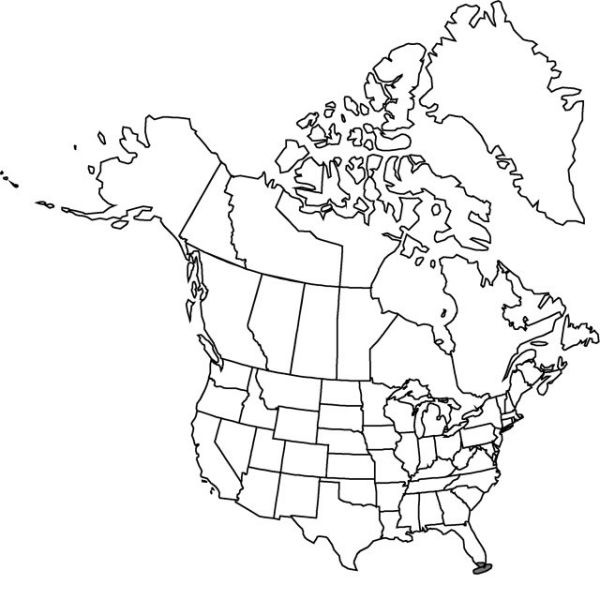Trichocentrum undulatum
Lindleyana 16: 225. 2001.
Plants epiphytic, lithophytic, or sometimes terrestrial, cespitose, to 3 m. Stems: pseudobulbs laterally compressed, 1–2 cm. Leaves from apex of pseudobulb, green, sometimes spotted or suffused with purple, elliptic to ovatelanceolate, 10–85 × 5–12 cm, margins entire. Inflorescences arcuate-pendent, 0.8–3 m (including peduncle); peduncle terete, 3.5–8 mm diam.; bracts distant, tubular sheaths, 6–15 mm, scarious; panicles open, branches few to several-flowered, 1–42 cm; floral bracts linearlanceolate, 3–5 (–10) mm, scarious. Flowers yellow (infrequently brown to green) with reddish-brown blotchy spots or not, fragrant or odorless; sepals clawed, margins undulate; dorsal sepal suborbiculate, rounded, 180–190 × 9–11 mm; lateral sepals broadly elliptic, 16–17 × 6–7 mm; petals clawed, broadly elliptic, 16–20 × 8–11 mm, margins undulate, apex obtuse; lip 3-lobed, pandurate, 16–19 mm, middle lobe ± reniform, 18–22 mm wide, margins undulate, apex retuse, lateral lobes basal, spreading, appearing auriculate, small, margins recurved, apex retuse; disc red with prominent, yellow, multi-horned callus composed of 2 pairs of tuberculate protuberances separated by lobed median ridge; column erect, white, wings prominent, 5–6 × 7 mm; ovary 24–30 mm. Capsules pendent, green, ellipsoid, 30–60 × 15–20 mm. 2n = 32.
Phenology: Flowering (Mar–)Apr–Oct.
Habitat: In understory of hilly broadleaf forests on tree trunks, rocks, or in leaf mold on limestone rocks
Elevation: 10–950 m
Distribution

Fla., Mexico, West Indies (Bahamas), West Indies (Greater Antilles), West Indies (Lesser Antilles), Central America, South America (to Colombia), South America (n Ecuador and Peru), South America (Venezuela), South America (French Guiana), South America (Surinam), South America (Guyana), South America (n Brazil)
Discussion
The nomenclature of this species has a complex and confusing history. Some have argued that Jacquin based his Epidendrum altissimum on an illustration published by Sloane, which is represented by the current concept of L. maculata. Consequently, this species was regarded as Oncidium altissimum (Jacquin) Swartz (L. A. Garay and H. R. Sweet 1972, 1974). Others, however, argued that Jacquin’s name was based on Jacquin’s collections and that Epidendrum altissimum does not refer to this species (R. L. Dressler and N. H. Williams 1975, 1982). The latter view has prevailed (R. K. Brummitt 1985).
Two names have been commonly associated with this concept. Oncidium luridum Lindley appears in floras and popular books (e.g., H. León 1946; E. Foldats 1969–1970, part 5; C. D. Adams 1972; C. A. Luer 1972; R. L. Dressler 1993; H. Bechtel et al. 1981; A. Gloudon and C. Tobisch 1995) even though several earlier names were well known. The second name, Oncidium guttatum (Linnaeus) Fawcett & Rendle, has been frequently placed in synonymy with Oncidium luridum but the Linnaean name applies to what has been known as Oncidium tetrapetalum (Jacquin) Willdenow or Tolumnia tetrapetala (Jacquin) Braem (M. Nir 1994).
Some authors have treated Oncidium undulatum as a synonym of Trichocentrum luridum, but R. P. Sauleda and R. M. Adams (1989) argued that they represent two distinct species. Although not explicitly stated, O. undulatum supposedly occurs in Florida, Bahamas, Cuba, and Jamaica whereas O. luridum represents plants of Mexico, Central America, and South America. The authors gave no indication as to the identity of those plants in the Lesser Antilles, and presumably Trinidad would be included with the South American plants. Oncidium luridum has a reniform lip, short-clawed and obovate to broadly elliptic sepals and petals, and simple column wings, whereas O. undulatum has a narrowly reniform lip, long-clawed, spatulate to obovate sepals and petals, and 2-lobed column wings. Oncidium undulatum has longer and wider leaves and inflorescences twice as long as those of O. luridum. Furthermore, the sepals, petals, and lip of Oncidium undulatum are yellow with reddish brown spots, and the sepals and petals of O. luridum are yellowish brown with brown blotches that usually overlap, while the lip is brownish orange without spots. None of the numerous characteristics that Sauleda and Adams use to differentiate the two taxa hold up to scrutiny except perhaps flower color.
Differences may yet be identified between the two, but the patterns of variation certainly need to be clarified. Some taxa are simply widespread and variable (cf. J. D. Ackerman and M. Galarza-Pérez 1991), and Trichocentrum undulatum could be one of those (F. R. Stermitz 1982, for Mexican populations). The oldest name available for the broader concept of this species is T. undulatum, which we use here, but our use of this epithet does not imply that we accept that the material in the Caribbean is distinct from the Central and South American material that is typically referred to T. luridum.
Selected References
None.
